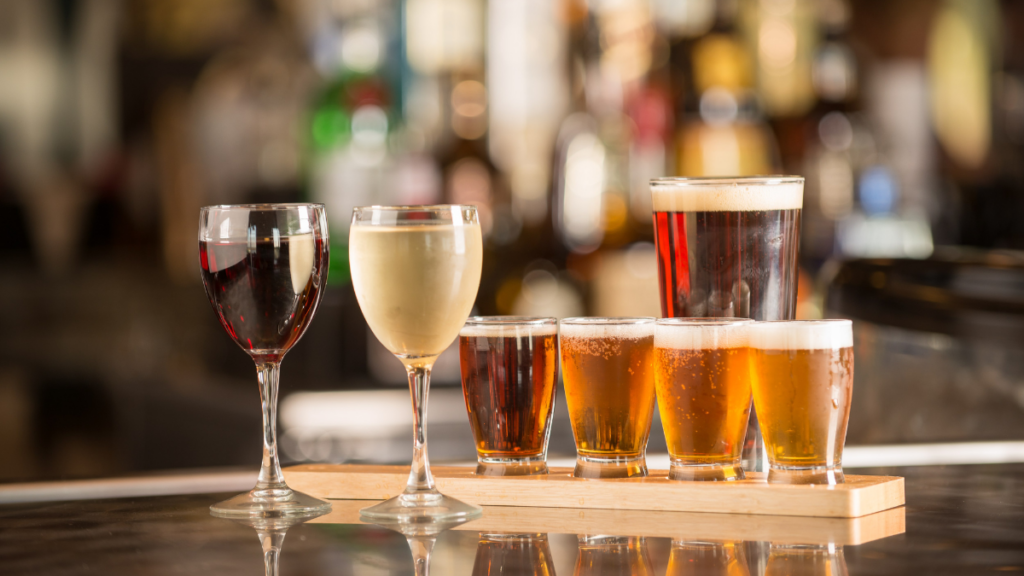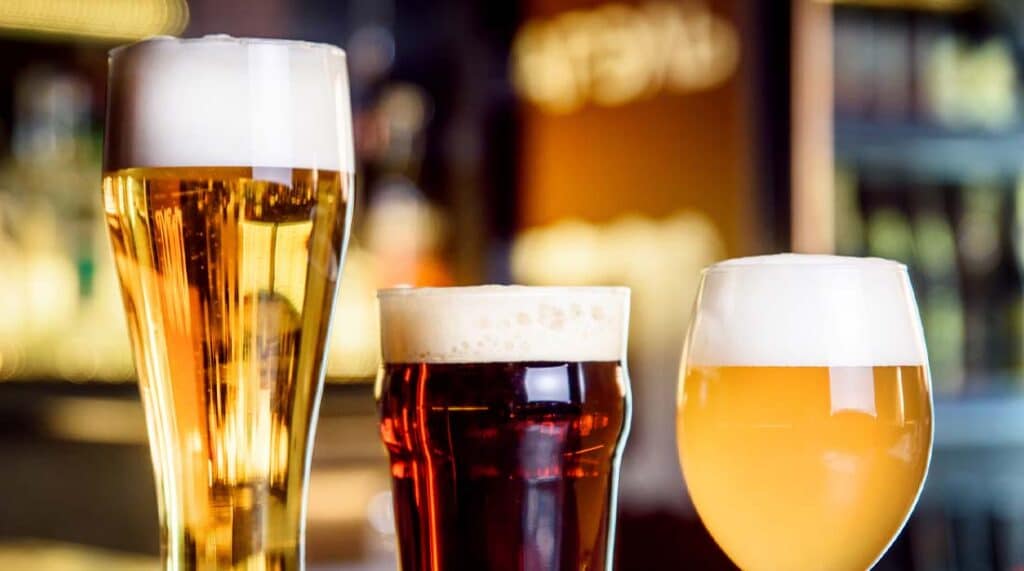Let’s talk about how to choose the best type of glass to complement your beer style. It most often seems as though there are only two choices when it comes to beer — a bottle or a pint glass. In truth, the glassware possibilities are endless. From the wide variety of types of beer glasses to the different sizes available, we’ll dive into the world of beer presentation and ensure your drinks are always served with style.
Why Are There So Many Drinking Glass Choices?
Knowing how to choose the best type of glass to complement your beer style and understanding the variety of beer glass types and sizes is key.
The different types of beer glasses available for beer consumption come in many eye-catching designs, but they also serve a specific purpose. From releasing carbonation at the proper rate and delivering taste to just the right location on the tongue, to perfectly capturing the aroma and escaping the frothy head, choosing the right glassware can make all the difference in your tasting experience.
For example, each style of beer glass is designed to do the following:
- Meet specific needs: Some glasses were created to solve problems at the time. For example, during the era of the Black Plague, craftsmen added a lid to German beer steins to keep flies out. The narrow base of this wheat beer glass allows the sediment to settle at the bottom, so the taste is not affected.
- Ensure that the form matches the function: The first glasses created were stoneware steins made to keep beer cold. Thick glass beer mugs were designed to withstand the abuse experienced in Germany’s pubs. The shape of snifters encourages the hand’s warmth to gently increase the beer’s temperature.
- Enhance and retain the beer’s head: The head helps retain a beer’s aroma, and the aroma can add or detract from your enjoyment. By shaping the glass to trap the head, glassmakers can enhance the beer-drinking experience.
Beer Glass Styles
Ready to take a sip into the world of beer glasses? We’ve got you covered! Here are the 10 must-have beer glass styles for your bar or restaurant.
1. Steins
Best For: Beers like American ales & lagers, Scottish ales, and Irish dry stout beer.
These iconic beer vessels have a rich history rooted in German beer culture. Since the early 1500s, the stein — short for “steinzeugkrug” and German for stoneware jug — has been made from a wide variety of materials, such as wood, earthenware and silver. The hinged lids, although originally designed to keep flies away during the Black Plague era, now serve as a way to maintain the temperature of the beer by trapping the aromas and preventing carbonation from escaping too quickly.
Today, the stein is more of a souvenir than everyday glassware. Although rooted in tradition, the stein is not high on practicality or convenience.

2. Mugs
Best For: Beers like American ales and lagers, Scottish ales, and Irish dry stouts.
These sturdy vessels are a staple in beer-drinking establishments worldwide. Evolved from the German beer stein, the glass mug serves a dual purpose:
- Durability. The thick glass and handled design make it easier to maintain a firm grip and safer to make loud, celebratory toasts.
- Insulation. The handle on the mug allows the beer to stay colder, as the warmth from your hand doesn’t affect the beer’s temperature.
With their thick glass construction, large handles and ample capacity, mugs are designed for a down-to-earth beer experience. Plus, the satisfying clink of a mug can create a festive atmosphere that adds to the overall enjoyment of the beer-drinking experience.
3. Goblets or Chalices

Best For: German bocks and maibocks, Belgian IPAs, Belgian ales, Belgian dubbels, tripels and quadrupels, and other beers with a high ABV.
Goblets, or chalices, are exquisite beer glass styles that exude sophistication and elegance. Best described as having a long, thick stem supporting a bowl, these glasses allow drinkers to hold the glass without warming the beer while enhancing the beer’s aromas. They elevate the drinking experience, making it feel like a special occasion, even if it’s just another day at your bar or restaurant.
A wide-mouth goblet is preferred for drinking beers with high gravity or alcohol by volume (ABV) for two reasons:
- The wide mouth maintains the beer’s head.
- The shape also lets the drinker take deep sips and analyze the aromas and flavor profile.
Goblets come in different sizes, often ranging from 8 to 18 ounces. They are frequently ornate, with silver- or gold-rimmed accents and decorative stems. Chalices may be heavier, with thicker walls than goblets, but they’re the same shape. Some chalices have etching on the bottom of the bowl. This attracts carbon dioxide and creates continuous bubbles that maintain a perfect head.
Don’t have either on hand? You can use an oversized, 22-ounce wine glass in a pinch. With the same open bowl as chalices or goblets, the wine glass offers the perfect headspace as well as the room to create an appealing nose.
4. Pilsner Glass

Best For: American lagers and pilsners, hefeweizens, and blonde ales. One of the best beer glasses for pale lagers with a lot of carbonation.
This tall and slender beauty is specifically designed to showcase the crisp and effervescent qualities of — you guessed it — pilsner beers. It’s also suitable for other lighter beers. The skinny design helps maintain the beer’s carbonation and showcases the beer’s color, clarity and carbonation. And the wider top, similar to the goblet, helps develop the aroma and flavor profile while maintaining the head. When customers see a pilsner glass on your menu, they know they’re in for a refreshing treat.
Although these glasses vary in size, they most often hold 10 to 16 ounces — holding less beer than most other glasses do. Pilsner glasses are often mistaken for Weizen glasses, but Pilsner glasses lack the Weizen’s curvature. The European version of the Pilsner glass, the pokal, has a short stem.
5. Tulip or Thistle Glass

Best For: The tulip glass is well-suited for stronger, aromatic brews, like double IPAs, and Belgian ales. And since Scotland’s official flower is the thistle, the thistle glass is typically used for Scottish ales.
These uniquely shaped beer glasses are a sight to behold and a delight to drink from. The tulip glass has a small stem and footer below a tulip-shaped bowl. Made to enhance flavors and aromas, this glass is perfect for malty and hoppy brews. The bowl has a rim that curves outward just slightly. The lip that forms help trap and emphasize the head. The bow of the rim lets the beer hit the tongue’s center and the stem prevents the hand from warming the beer.
The thistle is quite similar to the tulip; the difference lies in that it’s slightly taller and less curvy — resembling a thistle blossom. Its large glass bowl also allows for an enjoyable aroma release.
6. Weizen Glass

Best For: Weizenbocks, kristallweizens, or wheat ales.
This tall and curvaceous glass is specifically designed to complement wheat beers, showcasing their unique characteristics and providing an authentic drinking experience. The elongated shape of the Weizen glass allows for a generous pour while still leaving room for the thick, fluffy head that wheat beers are known for. The narrow bottom and flared top help maintain the carbonation and capture the rich aromas, transporting you straight to the beer gardens of Munich.
Often mistaken for a pilsner glass, the Weizen is identified by the defined curvature near the top and its ability to hold more than a pint glass. The German version generally holds 0.5 liters. The curved lip serves to trap the head, capturing the aroma for you to enjoy. We recommend that you politely decline the citrus garnish that often accompanies the wheat beer as the acidity is detrimental to the head.
7. Snifter

Best For: Higher-gravity, or higher-alcohol content beers, such as Belgian ales, India pale ales, and wheat wines.
This sophisticated and versatile glass style is a favorite among beer enthusiasts and connoisseurs for its ability to capture and enhance the complex aromas of certain beer styles. Although snifter glasses are usually used for cognac or brandy, they’re also perfect for big, aromatic beers.
The shape — a stemmed, big bowl that tapers at the top — traps and enhances the volatiles as they near your nose, while the glass itself fits snugly in your hand. Try swirling the beer, enticing the volatiles to release their full aroma. In this case, hand warmth is used to warm the beer to its optimal temperature.
8. Stange

Best For: Delicate beers, such as Kolsch, lambic, gueuze, or rye.
German for “rod,” Stange glasses are tall and slender. Although not visually stimulating — looking much like a Tom Collins glass — these glasses are a staple among connoisseurs. The Stange glass, with its cylindrical shape and relatively small size, is perfect for showcasing delicate and nuanced beers. Its slender design allows the beer’s carbonation and aroma to shine, delivering a crisp and refreshing drinking experience.
Generally holding 6.5 ounces, it amplifies the beer’s malt and hop volatiles, imparting a true sense of its flavor. The smaller size also encourages quick drinking while the beer is cold.
9. Flute

Best For: Fruit beers, krieks, biere de Champagne and Belgian lambics.
Of course, champagne first comes to mind when you mention flutes, but they’re perfect for certain beers, too. The long, narrow shape highlights carbonation — while ensuring it doesn’t dissipate too quickly — and color while allowing for a strong aroma to escape. Serving beer in a flute glass can elevate special occasions or be a unique twist for customers seeking a different beer-drinking experience.
10. Pint

Best For: Some say that this glass is near-perfect for a wide range of beers including American ales, lagers, IPAs, and pilsners. Others believe that no beer should ever be served in a shaker pint, especially big beers or those with big noses.
Ah, the mighty pint glass, a true icon in the world of beer. With its sturdy build and timeless design, the pint glass holds a special place in the hearts of beer enthusiasts and pub-goers alike. It’s the classic choice for enjoying a refreshing pint of your favorite brew.
The pint glass, with its cylindrical shape and wide mouth, offers a no-nonsense approach to beer drinking. It allows for easy sipping and showcases the beer’s color and clarity, inviting you to appreciate its visual appeal. The generous size of a pint glass also means you can enjoy a substantial amount of beer without having to constantly refill.
There are four kinds of traditional pints:
- American pint. The American, or shaker pint is probably one of the most recognizable, as its primary intent is for shaking cocktails. Simple in design, low in price, easy to stack, and made from thick glass, this glass is a staple in many US bars and restaurants. This 16-ounce glass can maintain cold temperatures while allowing good aroma release, although some say it allows for too much aroma release.
- Nonic, or British pint. Similar to the American pint, this glass allows for easier stacking and gripping due to a curved bulge about two inches below the rim. This bulge serves another purpose as well: adding a second layer of flavor and aroma as the beer passes over it. These 20-ounce glasses are perfect for all beers except high-ABV types.
- Imperial, or Irish pint. More often used for porters, Irish stouts, and other dark beers, this pint tapers and curves from the middle up. The slight bowl the curve creates near the top of the glass helps trap flavor and aroma and build a solid head.
- Tulip pint. Commonly used in Ireland and England to serve ales, this glass flares slightly from the middle of the glass up to the rim.
Beer Glass Sizes

Different types of beer glasses offer unique experiences. A smaller glass intensifies aromas and flavors, while a larger one enhances visual appeal and allows the beer to breathe. Consider the beer style and desired experience to choose the best size.
Experiment, have fun, and find the perfect fit for each beer. Your customers will appreciate the attention to detail, and their taste buds will thank you. Cheers to finding the perfect pour!
The Importance of Providing a Variety of Beer Glass Types for Customers
Although American bars typically serve their beers in one type of glass—shaker pint, anyone? — you can stand out from the crowd and provide your customers with a variety of beer glass types.
Ready to make your bar or restaurant the ultimate beer destination? Stock up on diverse beer glass types for a captivating experience:
- Enhances the experience: Different kinds of beer demand specific glasses that showcase their unique characteristics. Varied options elevate the visual appeal and drinking pleasure.
- Aromas and flavors galore: The right glass enhances aromas and flavors, allowing customers to fully savor their chosen beer. Providing specific glasses allows customers to enjoy the full spectrum of their chosen beer’s aromas and taste.
- Style and sophistication: Offering a range of beer glasses adds style and sophistication, demonstrating your appreciation for the craft. Customers will have the opportunity to experiment and find their preferred vessel for sipping their favorite brews.
Create a Self-Pour Wall for Your Customers
Understanding the different types of beer glasses to complement your beer style is crucial for enhancing the overall drinking experience. But why stop at just the glass? Take your beer service to the next level by creating a self-pour wall for your customers.
With PourMyBeer’s self-pour stations, you can offer a unique and interactive experience that allows patrons to pour their own beer, wine and cocktails. It’s a win-win situation — customers enjoy the freedom and fun of pouring their own drinks, and you benefit from increased efficiency and customer satisfaction.
Request a quote today and raise a toast to a memorable beer-drinking experience!










